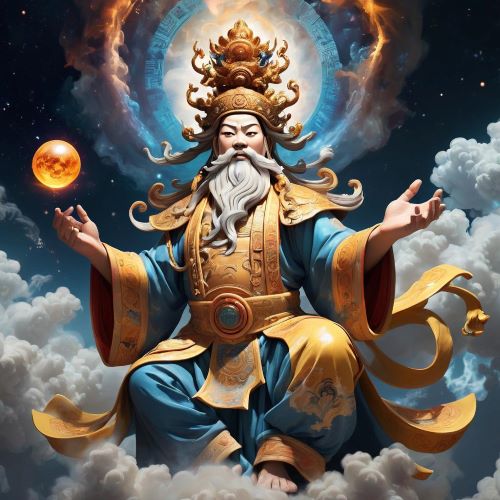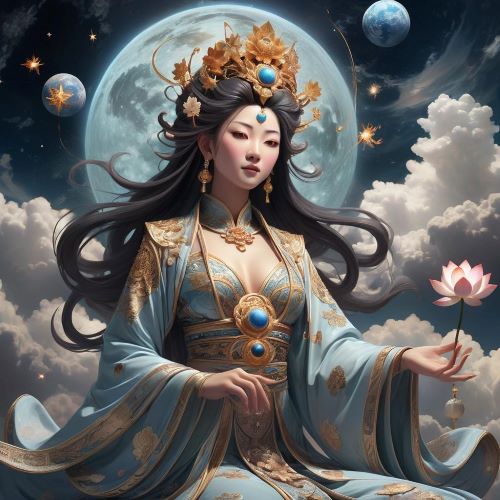Bixia : Goddess of Childbirth
Listen
At a glance
| Description | |
|---|---|
| Origin | Chinese Mythology |
| Classification | Gods |
| Family Members | Dongyue Dadi (Father) |
| Region | China (Shandong Region) |
| Associated With | Childbirth, Destiny |
Bixia
Introduction
Bixia Yuanjun is the goddess of Mount Tai . She is regarded as the “primal” sovereign of the colored clouds of dawn and the embodiment of the divine feminine in the Chinese tradition of Taoism. In China, Bixia Yunjun was a significant deity during the Qing and Ming dynasties. She was also associated with various other deities, such as the Bodhisattva Guanyin. In Chinese mythology, Bixia is regarded as a fertility goddess who protects young children and mothers. Her full name is Bixia Yunajun, which literally means “Her Majesty of the Blue Dawn,” though she is sometimes referred to simply as Bixia.
Physical Traits
Her headdress is adorned with multiple phoenixes, which are prominent elements of her iconography. Bixia typically appears with a pendant on her legs and a tablet that bears the image of the Big Dipper as a representation of her authority.
Family
Bixia Yuanjun is a composite image of various historical figures. Some believe that she is the daughter of Dongyue Dadi, who is the titular deity of Mount Tai. Others believe that she is the daughter of judge Yanluo, who was also a subordinate of the former. According to Ming sources, Bixia was the daughter of an ordinary citizen. In 1008, a statue of her was discovered on a holy mountain by the Song Dynasty’s emperor, who was identified as Zhenzong.
Other names
Bixia also has a second name, which is Houtu. This is composed of the characters for “queen,” “hou,” and “tu,” which literally means “Earth.” This second name is commonly referred to as the Queen of the Earth. She is sometimes also called the “Heavenly Immortal Lady.”
Powers and Abilities
In North China, the deity known as Tai Shan Niangniang gained widespread popularity during the early Qing and Ming dynasties. Her influence was spread by the city of Tai’an in Shandong Province, and her admirers also extended to the lower Yangzi region. This has had a huge impact on the culture of China’s northern regions. As the goddess of the morning, she presides over the arrival of each new day as she rises in the clouds. She is also the goddess of childbirth, and she is often requested by women seeking to have children to help them achieve their goals. Bixia Yuanjin can be found at the Temple of the purple Dawn at Mount Tai. When China’s Yellow River was suddenly diverted during the Great Flood, Bixia saved countless lives by returning it to its normal course. She is a widely worshipped deity in the country’s north. Her identity is sometimes linked to that of Xiwangmu.
Modern Day Influence
The Bixia Gong Temple was constructed at the top of Mt. Tai during the Ming period and is still regarded as a pilgrimage site. In various cities in China, there are temples dedicated to Bixi Yuanjun. One of these is the Temple of the East Peak in Beijing, which has a hall dedicated to Bixia.
Bixia appears in the video game Dynasty Warriors: Orochi 4 as a playable character. She is shown to be a young woman with a phoenix crown and blue hair, and she is using her fans to fight against a powerful serpent god known as Orochi. Bixia is a significant character in the Journey to the West series. She is the child of the god of Mount Ta, as well as the sister of a powerful warrior god known as Erlang Shen. When Tang Sanzang’s group is trying to recover Buddhist scriptures from India, Bixia is among the individuals who join them. She often competes with Sun Wukong for his attention.
Related Images
Frequently Asked Questions
What is lorem Ipsum?
I am text block. Click edit button to change this text. Lorem ipsum dolor sit amet, consectetur adipiscing elit. Ut elit tellus, luctus nec ullamcorper mattis, pulvinar dapibus leo.
What is lorem Ipsum?
I am text block. Click edit button to change this text. Lorem ipsum dolor sit amet, consectetur adipiscing elit. Ut elit tellus, luctus nec ullamcorper mattis, pulvinar dapibus leo.
What is lorem Ipsum?
I am text block. Click edit button to change this text. Lorem ipsum dolor sit amet, consectetur adipiscing elit. Ut elit tellus, luctus nec ullamcorper mattis, pulvinar dapibus leo.
What is lorem Ipsum?
I am text block. Click edit button to change this text. Lorem ipsum dolor sit amet, consectetur adipiscing elit. Ut elit tellus, luctus nec ullamcorper mattis, pulvinar dapibus leo.
What is lorem Ipsum?
I am text block. Click edit button to change this text. Lorem ipsum dolor sit amet, consectetur adipiscing elit. Ut elit tellus, luctus nec ullamcorper mattis, pulvinar dapibus leo.











